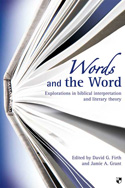Words and the Word: Explorations in Biblical Interpretation and Literary Theory
 David G. Firth and Jamie A. Grant, eds., Words and the Word: Explorations in Biblical Interpretation and Literary Theory (Downers Grove: InterVarsity, 2008), 317 pages, ISBN 9780830828982.
David G. Firth and Jamie A. Grant, eds., Words and the Word: Explorations in Biblical Interpretation and Literary Theory (Downers Grove: InterVarsity, 2008), 317 pages, ISBN 9780830828982.
Prior to the post-modern period, many of the critical methodologies used in biblical studies such as redaction criticism, form criticism and source criticism were used in biblical interpretation in order to aid the critic in the interpretation of a text’s pre-history. In contrast, literary theory focuses on the final form of the text. The editors of this collection seek to expose the reader to many of the multiple methods of literary theory as they relate to biblical interpretation.
Eight essays are included in Words and the Word and they fall into two parts: First, two general articles. Grant Osborne lays out the components of narrative theory, focusing specifically on how this can be used with the Gospels. Fanie Snyman provides a “responsible” and “non-technical” approach to exegesis of Old Testament narrative (61). Both Synman’s and Osborne’s discussions are clear and comprehensive.
Part two of the book is comprised of six essays, which discuss specific literary approaches to interpretation. First, Richard Briggs offers one of the most helpful explanations on speech-act theory I have encountered, including well-defined key terminology that is necessary for comprehending this concept. Speech-act theory understands that language has the ability to govern significant aspects of human life. Briggs claims the biblical writers were very cognizant of the profound power of words (85).
Jeannine Brown’s chapter on genre criticism is characteristic of all the essays in this collection—the methodologies all aim at discovering authorial intention. Brown reminds us that even genres were tools that biblical authors employed to communicate a specific message (143).
Many literary scholars assert that at certain times in their writing authors of the Bible intentionally employed ambiguity and willfully invited “readers to enjoy and play with the text” (183). David Firth argues for this practice as his contribution to the collection of articles. In an interesting piece, Firth attempts to show how William Empson’s taxonomy of ambiguity is a useful tool in which to explore biblical narrative. While Firth’s explanation and presentation is thorough and includes plenty of examples, I remain unconvinced (but open) that any ambiguity in the text is anything but unintentional.
Jamie Grant contributes an essay on poetics. The bulk of the essay deals with the significance of editorial shaping within anthologies like Proverbs and the book of Psalms. Grant demonstrates the importance of discerning a passages’ theme based on its placement by the editor within a particular thematic section of the book. Plenty of examples help to clarify this form of analysis. His chapter also includes a section on poetic parallelism and an even smaller discussion about New Testament poetry.
Peter Phillips explores the philosophical development of rhetoric, the art of persuasion. Although his essay contains some biblical examples to demonstrate his approach, this chapter and the next are two of the more theory-laden of the collection.
The final piece on discourse analysis, written by Terrance Wardlaw, might be one of the least known of the literary approaches discussed in the book. Wardlaw’s definition of discourse analysis is “the analysis of language and its use beyond the sentence. Moreover, one may describe ‘discourse’ as a unit of speech (either oral or written) treated by interlocutors as a complete utterance” (268). Wardlaw applies his analysis to both an Old and New Testament passage in order to help illuminate this theory.
Category: In Depth, Summer 2011


